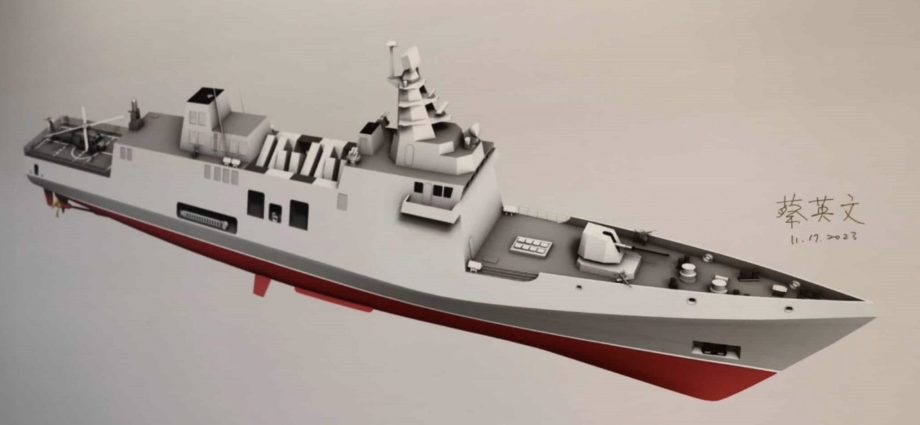Taiwan is building a next-generation anti-submarine frigate while stepping up tests of its indigenous submarine amid a rising strategic debate over how best to balance its traditional and unconventional warfighting capabilities.
This month, Naval News reported that Taiwan has begun construction on a new light frigate for the Republic of China Navy (ROCN) with a hard focus on anti-submarine warfare vis-à-vis China, which has persistently threatened to “reunify” the self-governing island by force.
Taiwan’s frigate project, which previously stalled due to budget issues, poor decision-making and the National Chung-Shan Institute of Science and Technology’s (NCSIST) inability to develop an AESA radar suitable for the 4500-ton hull, has been reoriented on building two 115-meter-long frigates with displacements of 2,500-3,000 tons.
Naval News mentions that the first ship, the anti-air warfare (AAW) variant, began construction in November 2023. Ten follow-on ships are planned after delivery of the first two prototype ships in 2026.
The frigates will be classed as Tier 2 combat ships for air defense, patrolling the Taiwan Strait, conducting reconnaissance and surveillance missions, escorting transport ships and supplies to remote islands, securing sea lines of communication and supporting military exercises and training.
Both variants were designed by American naval architecture firm Gibbs & Cox, with a variation being proposed for Australia.
The light frigates will be equipped with CMS-330 Combat Management System (CMS), BAE ARTISAN radar, 76mm cannon, TC-2N surface-to-air missiles (SAM), HF-3 anti-ship missiles (ASM), Phalanx Close-In Weapon System (CIWS) and S-70C ASW helicopters.

At the same time, Taiwan’s first indigenous defense submarine, known as Hai Kun, is undergoing harbor acceptance tests and is expected to begin sea acceptance tests late next month, the Taipei Times reported this month.
Taipei Times says that the Hai Kun-class hulls will be produced in batches of three, two and three, with the two Chien Lun-class submarines remaining in service after upgrading.
The report notes that the program would give the navy a fleet of 10 attack submarines to deter People’s Liberation Army-Navy (PLA-N) submarines and surface vessels, with eight submarines being the bare minimum and double that number the ideal fleet size.
For armament, the Taipei Times says that the Hai Kun is armed with 18 MK-48 Mod 6 Advanced Technology (AT) heavyweight torpedoes and can launch other kinds of missiles, with foreign-manufactured weapons being the most likely choice.
Taipei Times says that the Hai Kun’s launch showed that Taiwan could meet most of the requirements to produce submarines, although some key technologies were obtained from foreign partners.
It also says that eight Hai Kun-class attack submarines are necessary to give the navy the capability to conduct simultaneous single-vessel patrols in the Miyako Strait and waters southwest of Taiwan proper.
However, Taiwan’s simultaneous development of a frigate and submarine may point to a naval force design dilemma caused by competing imperatives of striking an asymmetric force posture to counter China’s gray zone tactics and the traditional force needed to repel a potential invasion.
In a June 2023 article for USNI News, Tim Fish notes an ongoing debate about whether a traditional naval buildup or an asymmetric force posture best meets Taiwan’s security needs.
Fish mentions that while Taiwan is more focused on building a highly visible conventional naval force to counter China’s gray zone tactics, the approach does not address China’s overwhelming force advantage.
He argues that Taiwan’s bid to split its force design and development by procuring assets that can conduct both traditional and asymmetric warfare will potentially leave it vulnerable in both regards.
In an August 2023 article for Popular Mechanics, Kyle Mizokami notes that since the Kuomintang (KMT) fled to Taiwan in 1949 during the last days of the Chinese Civil War, the self-governing island has maintained strong traditional naval and air forces on the fanciful premise that it would someday retake the Chinese mainland.
Mizokami points out that the proposition was not viable at the start and that since China lacked the capacity to invade Taiwan back then, Taiwan’s naval and air forces were more about posturing.
Now, however, Taiwan is overwhelmingly overmatched by China, with Taipei’s high-end fleet of destroyers, frigates and amphibious assault ships of questionable value in repelling a potential Chinese invasion.
Fish says that while Taiwan needs a highly visible traditional naval force to counter the PLA-N’s constant encroachment on its territories, China’s activities are more peacetime and low-intensity annoyances than existential threats.
He also points out that if the ROCN continues to build its forces around large, traditional warships, those ships will likely be destroyed quickly in the event of an invasion.
In a November 2023 article for the Cato Institute think tank, Eric Gomez says that Taiwan’s survival will not hinge on how well it could fend off China’s gray zone activities or limited uses of force such as blockades and bombardment campaigns that are unlikely to succeed, but rather on repelling an amphibious invasion with asymmetric capabilities.
Gomez argues that Taiwan must focus on two military operations: first, to survive an initial bombardment, and second, to prevent the seizure of ports, airfields and beachheads during the initial hours of an invasion.

While Taiwan’s new light frigates may be of more value in countering China’s routine surface and underwater intrusions into Taiwan’s territories, submarines may soon become Taiwan’s capital ships should it fully commit to an asymmetric warfare posture.
In a December 2023 Taiwan Strategists journal article, Ming-Shih Shen says that Taiwan’s future submarine force will provide island-round protection to prevent the PLA-N from enforcing a blockade or crossing into the First Island Chain to encircle Taiwan.
While Shen notes that the traditional submarine “wolf pack” doctrine to hunt major surface combatants is not suited for asymmetric warfare, Taiwan could deploy its submarines defensively using ambush tactics and other unconventional methods to attack China’s submarines and large surface ships.

